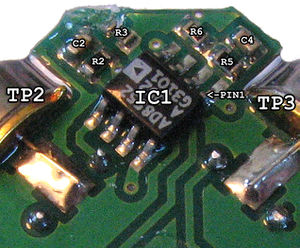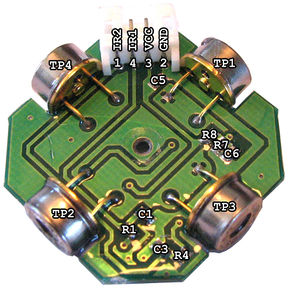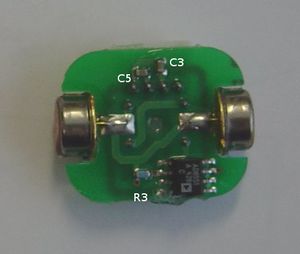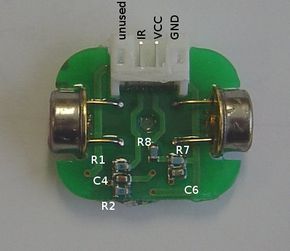Difference between revisions of "Other Infrared Sensors"
| Line 1: | Line 1: | ||
= FMA Direct Co Pilot Sensor Boards = | = FMA Direct Co Pilot Sensor Boards = | ||
The [http://www.fmadirect.com FMA Direct] horizontal (X-Y) and vertical (Z) sensors are inexpensive, readily available, and perfectly suited for use with all versions of the Paparazzi autopilot. These sensors are only available direct from FMA ''Direct'' | The [http://www.fmadirect.com FMA Direct] horizontal (X-Y) and vertical (Z) sensors are inexpensive, readily available, and perfectly suited for use with all versions of the Paparazzi autopilot. These sensors are only available direct from FMA ''Direct''.<br> | ||
Purchase both the X-Y sensor: [http://www.fmadirect.com/detail.htm?item=1778§ion=20 CPD4SENUNIT] and Z sensor: [http://www.fmadirect.com/Detail.htm?item=1888§ion=49 FS8ZS] for optimum performance. The sensor boards are coated with a very thick lacquer that is difficult to penetrate while soldering. Do not remove more coating than necessary as it prevents the very high value resistors from drifting with humidity changes. | Purchase both the X-Y sensor: [http://www.fmadirect.com/detail.htm?item=1778§ion=20 CPD4SENUNIT] and Z sensor: [http://www.fmadirect.com/Detail.htm?item=1888§ion=49 FS8ZS] for optimum performance. The sensor boards are coated with a very thick lacquer that is difficult to penetrate while soldering. Do not remove more coating than necessary as it prevents the very high value resistors from drifting with humidity changes. | ||
Revision as of 01:18, 24 July 2010
FMA Direct Co Pilot Sensor Boards
The FMA Direct horizontal (X-Y) and vertical (Z) sensors are inexpensive, readily available, and perfectly suited for use with all versions of the Paparazzi autopilot. These sensors are only available direct from FMA Direct.
Purchase both the X-Y sensor: CPD4SENUNIT and Z sensor: FS8ZS for optimum performance. The sensor boards are coated with a very thick lacquer that is difficult to penetrate while soldering. Do not remove more coating than necessary as it prevents the very high value resistors from drifting with humidity changes.
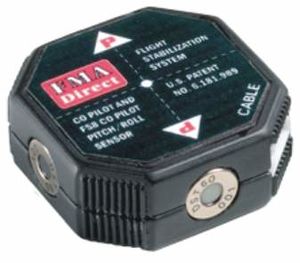 FMA X-Y Sensor CPD4SENUNIT |
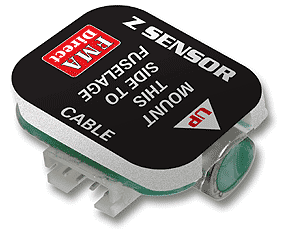 FMA Z-sensor FS8ZS |
Pinouts and Optional Gain Adjustment
The FMA sensors were designed to operate from a 5V source but are typically powered in Paparazzi installations with 3.3V, ensuring that the sensor's analog output does not exceed the 3.3V limit of the ADC inputs on the ARM7 microprocessor. The sensors work well at 3.3V but their amplifier gain is effectively increased by a factor of 5/3.3.
- If the gain is too high and/or the airfield contrast is also too high, the sensor could saturate (reach it's maximum possible reading) well before the aircraft has pitched/rolled 90 degrees, resulting in a tendency for the plane to underbank/underpitch and drift off course.
- If the gain is too low and/or the contrast is too low, the noise and neutral-offset of the sensor can become dominant, resulting in a tendency for the aircraft to be out of trim and potentially overbank/overpitch in one direction and crash.
Either extreme is bad, of course, but it should be noted that these are only extremes. For reference, a stock FMA sensor run on 3.3V will saturate when flying over black asphalt on a very hot, dry Arizona day, a modified sensor will not. Similarly, a modified sensor will show more signs of neutral-offset when operated in cloudy weather or other low contrast situations. It is suggested that sensors only be modified if needed for very high contrast locales.
Make sure that the IR1 output from the XY sensor goes to IR1 input of the Tiny and that the IR2 output from the XY sensor goes to the IR2 input of the tiny board.
- XY sensors from FMA have the plug connected as:
- 1) Gnd;
- 2) +3.3v;
- 3) IR1;
- 4) IR2;
- But on the tiny board the plug is connected as:
- 1) Gnd;
- 2) +3.3v;
- 3) IR2;
- 4) IR1.
Horizontal Sensor Modification
The stock FMA resistors R2/R3 and R5/R6 (0603 0.8 Mohm/0603 510 ohm) set the op amp gain to approximately 1600. Since this unit is designed to run on 5V and we are running it on 3.3V, we can change R3 and R6 from 510 ohm to 1K ohm to reduce the gain to around 800. Another option is to replace R2 and R5 with 560 Kohm resistors, generating an output gain of approximately 1100; a gain which is practically identical to that of the Paparazzi board.
a suitable resistor from mouser is here
| R1 | 200 ohm |
| R2 | 0.8 Mohm |
| R3 | 510 ohm |
| R4 | 200 ohm |
| R5 | 0.8 Mohm |
| R6 | 510 ohm |
| R7 | 600 ohm |
| R8 | 600 ohm |
| C1 | 0.026 uF |
| C2 | 0.026 uF |
| C3 | 0.026 uF |
| C4 | 0.026 uF |
| C5 | 0.01 uF |
| C6 | 0.026 uF |
Vertical Sensor Modification
The same operation can be done with the vertical sensor by changing R3 from 510 ohm to a 1K ohm.
a suitable resistor from mouser is here
